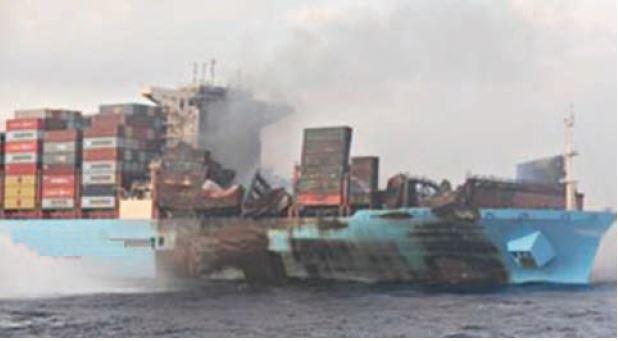202115 Nightmare fire scene
As edited from TSIB (Singapore) MIB/MAI/CAS.035
A very large, recently constructed container ship was loaded and underway in darkness when a smoke alarm sounded in number 3 cargo hold. With the Master on the bridge, the Chief Mate went to the muster/fire control station. He was in charge of the Emergency Team, and besides mustering (including headcount) he would oversee the firefighting and boundary cooling operation. The Master noted the apparent wind about four points on the starboard bow and adjusted the vessel’s heading to starboard to minimise the effect of smoke on the accommodation, but maintained speed.
On the starboard side main deck, crew closed all 16 natural ventilation flaps for hold 3, but were unable to complete this task on the port side due to heavy smoke and heat. Some of the crew reported a strong chlorine-like smell while closing the ventilation flaps on the cross deck, and suffered some breathlessness with itchy burning sensations.
About 30 minutes after the first alarm the Master opted to release the appropriate amount of CO2 into the hold for the safety of the ship and its crew, although the ventilation flaps on the port side could still not be closed. Boundary cooling continued on deck but copious amounts of smoke were coming from hold 3. Thirty minutes after the first release of CO2, the Master ordered all non-essential crew to the bridge and ordered a second release of CO2.
About seven minutes after the second CO2 release, the water mist system in the engine room auto-activated, indicating that temperatures in the engine room were possibly elevated. Soon afterwards, the Master ordered a distress call. All remaining crew were ordered to the bridge. About 15 minutes later, the Master had all of the remaining CO2 released into hold 3, but there was little effect. Ten minutes after this, with the majority of the crew now in the wheelhouse, acrid smoke entered the space and created a panic reaction. Crew evacuated the bridge and broke up haphazardly into four groups.
Almost an hour after the evacuation of the wheelhouse, a group of seven crew and the Master boarded the starboard lifeboat and successfully abandoned ship. Once in the water they took on 14 other crew that had already abandoned in a liferaft and another one from the water. Of the 27 crew, 23 survived although the one crew recovered from the water later was pronounced deceased.
The official investigation found, among other things, that no. 3 cargo hold contained a block stowage of 55 containers of sodium dichloroisocyanurate dihydrate (SDID). It is possible that the cargo in one or more of these containers underwent self-decomposition. The block stowage exacerbated the rate of reaction and heat production which resulted in the uncontrollable spread of the fire.

Lessons learned
- The complexities and interconnected risks of large modern container ships, including loading of certain dangerous cargoes below deck, may have outstripped the current accepted best practices and fire fighting arrangements, not to mention fire fighting training of crews on these ships.
- One example of the above: how are the crew to safely close all of the ventilation flaps manually when heat and smoke are present? In this case it was not possible. Although this arrangement conforms to class rules, maybe it is no longer suitable.

Natural ventilation flaps (Sister ship)
- It is important to close the ventilator flaps/dampers in the accommodation and machinery spaces for the protection of the crew, even for an under-deck cargo fire.
- For at least 90 minutes after the fire was discovered, the Master maintained a fairly high speed of at least 15 knots. Best practice would have the ship brought quickly to bare steerage to reduce apparent wind while still keeping the management of smoke in mind. Although he was intending to reduce the effect of smoke on crew engaged in firefighting, this could have been done at a very slow speed with helm adjustments and thrusters.
There are many more lessons learned from this report than it is possible to list here. Interested readers should visit the full report at the Singapore Ministry of Transport website. It can be found at https://bit.ly/39k3c4F or by searching the file reference given at the beginning of this report.
